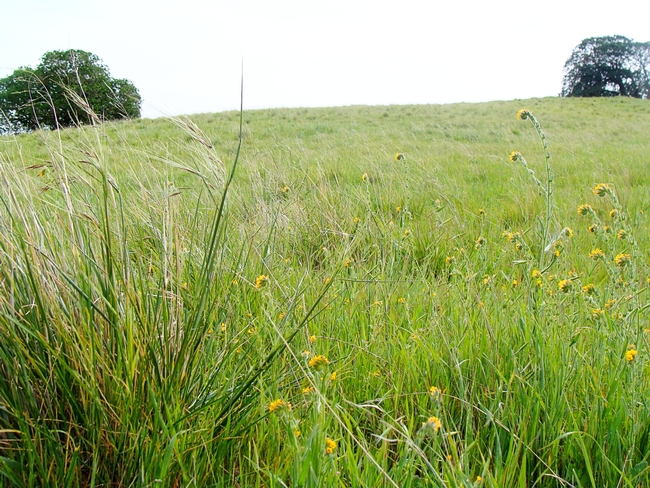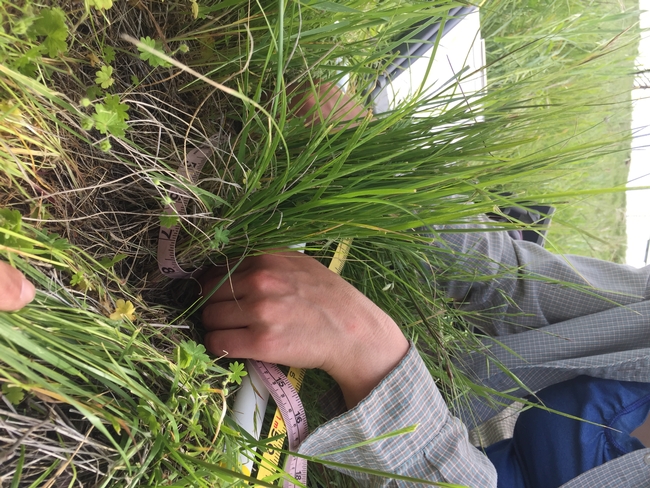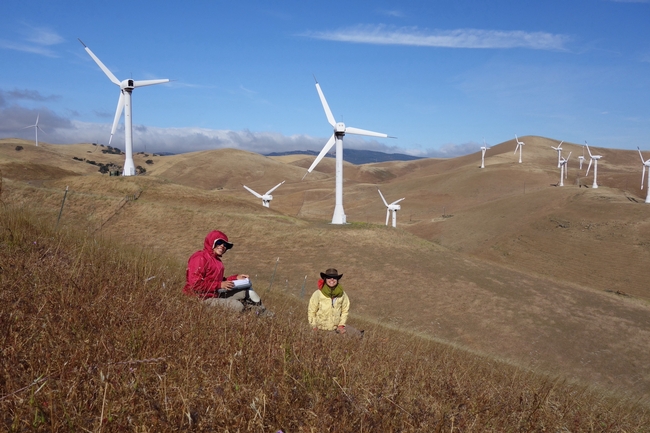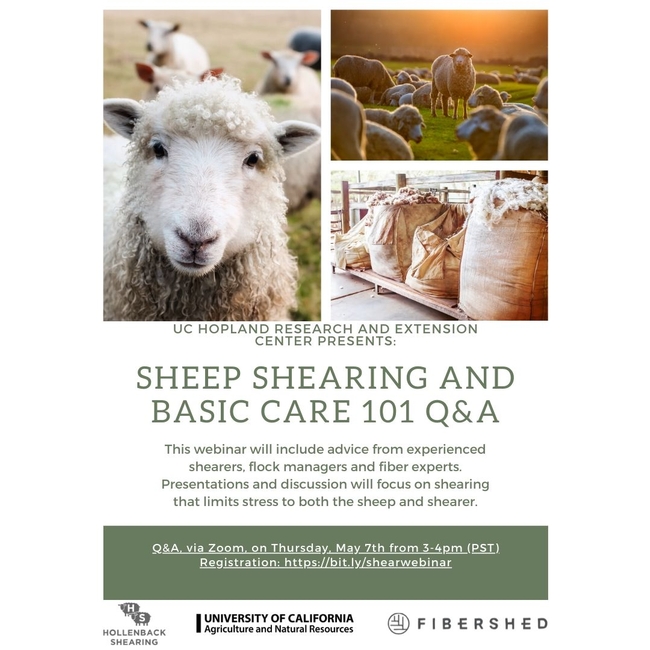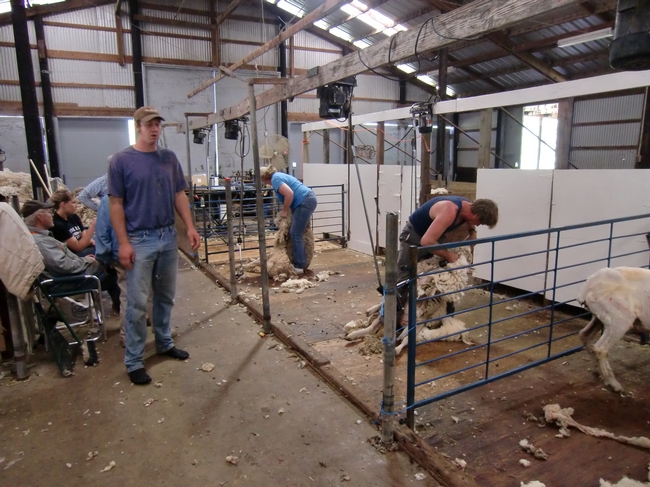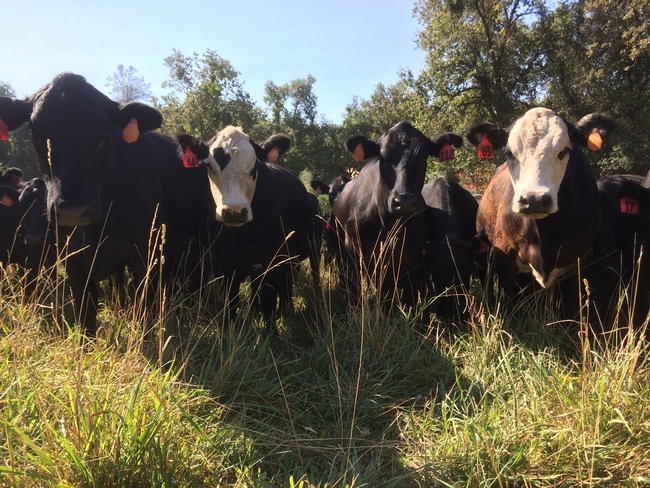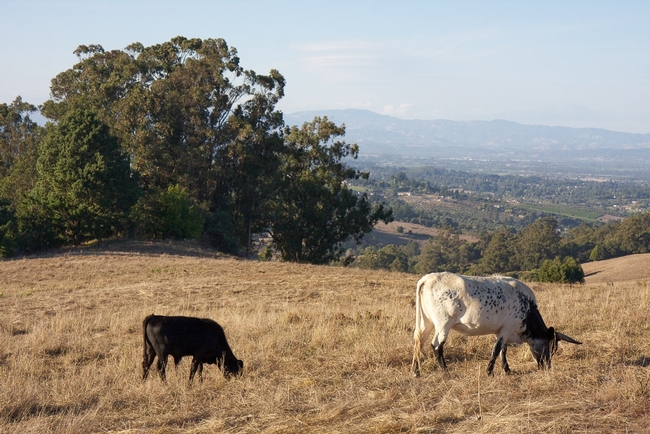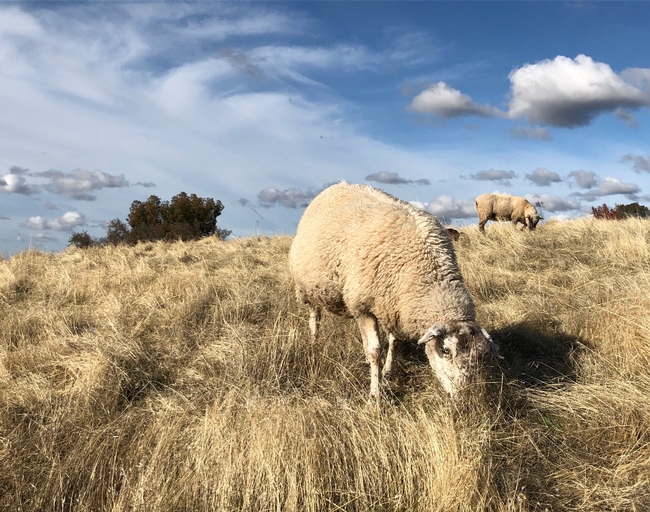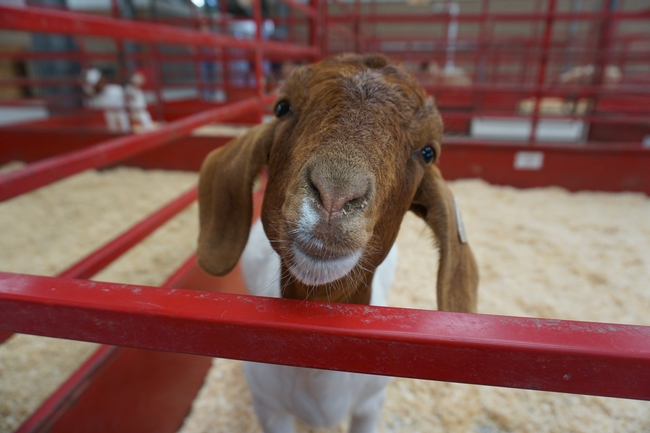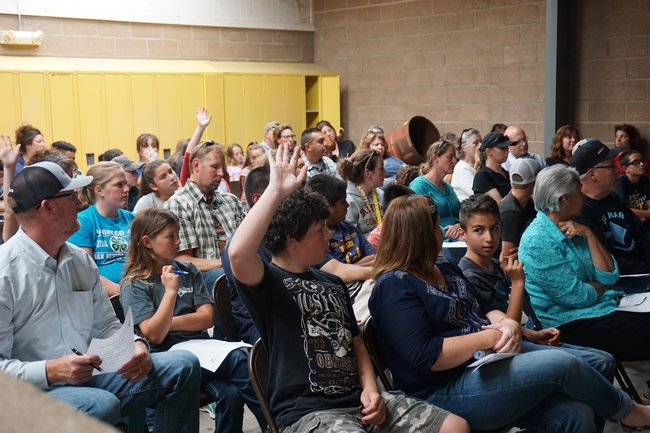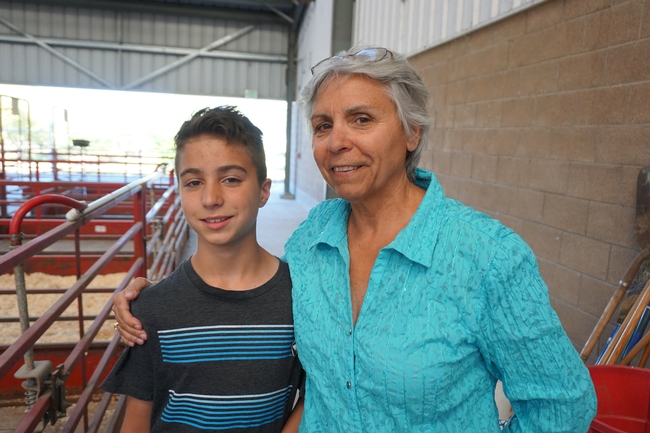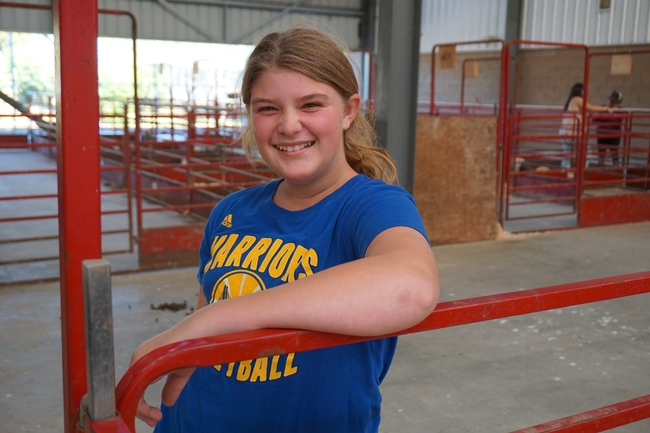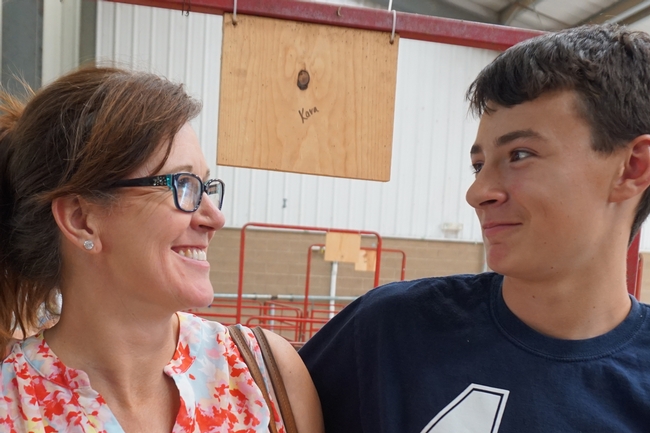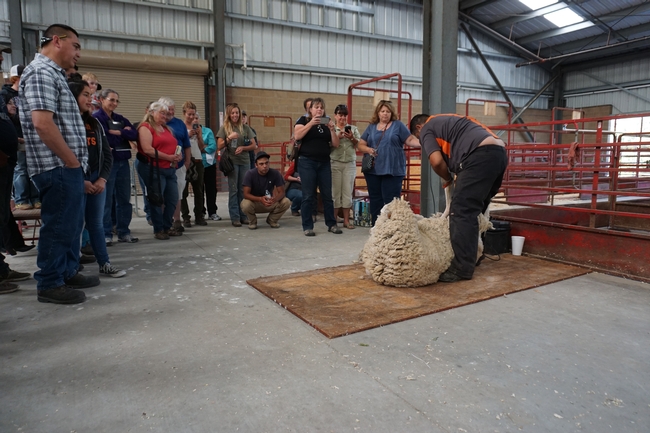Posts Tagged: sheep
The no-tech way to preserve California’s state grass
Disappearing native is like an environmental Swiss Army knife
Though it is disappearing, California's official state grass has the ability to live for 100 years or more. New research demonstrates that sheep and cattle can help it achieve that longevity.
Purple needlegrass once dominated the state's grasslands, serving as food for Native Americans and for more than 330 terrestrial creatures. Today, California has lost most of its grasslands, and the needlegrass occupies only one tenth of what remains.
It is drought resistant, promotes the health of native wildflowers by attracting beneficial root fungi, burns more slowly than non-native grasses and speeds the postfire recovery of burned lands. For these and other reasons, many who work toward habitat restoration hope to preserve the needlegrass.
“Where it grows, these tall, slender bunches become focal points, beautiful as well as environmentally beneficial,” said Loralee Larios, a UC Riverside plant ecologist affiliated with UC Agriculture and Natural Resources. “However, identifying successful management strategies for a species that can live for a couple hundred years is challenging.”
To meet that challenge, Larios teamed up with University of Oregon plant ecologist Lauren Hallett and Northern California's East Bay Regional Park District. They tracked the health of nearly 5,000 individual needlegrass clumps over six years, including an El Niño rain year as well as historic drought.
The researchers took measurements of plant health including growth and seed production. They placed small bags over many of the grass clumps to capture the seeds and quantify the number of seeds they produced.
Their findings, now published in the Journal of Applied Ecology, were that purple needlegrass did better in places where sheep were allowed to graze. The positive effects of the grazing were amplified in times of wetter weather.
Previously, the park district spent a decade trying to assess the success of its grassland maintenance techniques. However, the district's method of applying a strategy like grazing, and then measuring the percentage of needlegrass clumps in a given area resulted in data that didn't follow a discernable pattern from year to year.
“By tracking each plant over time, rather than scanning broadly across an area, we gained much more clarity about how the grass responds to the grazing,” Larios explained. “Perhaps counterintuitively, we saw that the needlegrass generally died back when sheep weren't allowed to graze on it.”
When sheep were removed from the study sites, the needlegrass in all but two of the sites became less healthy. The researchers would like to learn whether the two sites that remained healthy have needlegrasses that are genetically distinct.
Grazing is a controversial strategy for grassland restoration. Some conservationists believe sheep eating the target grass, particularly during already stressful drought years, does not enhance their survival. As far back as the 1800s, some researchers hypothesized that the combination of grazing and drought resulted in the loss of perennial grasses.
Though drought was not beneficial for any of the plants in this study, the researchers believe grazing helped needlegrass survive in at least two ways. One, by trampling on leaf litter and other organic debris, sheep created space for new needlegrass to grow.
“Sometimes you get litter that's as deep as a pencil — so much dead, non-native grass piles up. It's hard for a little seed to get enough light through all of that,” Larios said.
Secondly, sheep eat non-native grasses that generate growth-suppressing debris and compete with purple needlegrass for resources.
When the Spanish colonized California, they brought forage grasses like wild oats that they thought would benefit cattle. Those introduced grasses spread, and now dominate the state's grasslands.
“Our grasslands are known as one of the world's biggest biological invasions,” Larios said.
California has as many as 25 million acres of grasslands, equivalent to the combined areas of Massachusetts, Connecticut, and Rhode Island. Though Larios does not believe it is possible to rid the state of all non-native grasses, she said it is possible to maintain or even increase the amount of purple needlegrass.
“It's great for carbon storage, which mitigates climate change, it doesn't serve as wildfire fuel, and cultivates a space for wildflowers that pollinators are then able to use,” Larios said. “We want to keep all those benefits.”
Webinar: Sheep shearing and basic care 101
The University of California Hopland Research and Extension Center (HREC) will offer a sheep shearing and basic care Q&A via Zoom from 3 to 4 p.m. May 7. The session will include advice from experienced shearers, flock managers and fiber experts.
Presentations and discussion will focus on shearing that limits stress to both the sheep and shearer. We also encourage your questions regarding sheep handling, husbandry, flock health, running a mobile shearing service, ethical shearing, grazing for fuel reduction and climate beneficial ranching practices. This webinar will take the place of the planned Sheep Shearing and Basic Care 101 immersive workshop planned at HREC in Spring 2020.
Participants in the webinar may also be interested in learning more about the class planned for 2021. Due to these unprecedented times, you do not have to have been registered for the Sheep Shearing 101 class to attend this Q&A session.
The session is free, but registration is required. Click here to register for the webinar and to share your questions.
Speakers:
Ruthie King
King is a shepherd focused on intensive rotational grazing for soil building, ecosystem restoration, fuel reduction and nutrient/water cycling. She raises Icelandic and Targhee sheep and sells meat, wool, and pelts through direct marketing. Services she offers include sheep shearing and contract grazing.
Alison Smith
Smith is the shepherd of the flock of over 200 sheep at the UC Hopland Research and Extension Center. She also supports research and extension at the site.
Trevor Hollenback
Owner/operator of Hollenback Shearing, Hollenback has been professionally trained and employed as a shearer in the United States, New Zealand, Australia, and Austria. His primary focus in shearing is limiting stress to both the sheep and shearer.
Rebecca Burgess
Burgess is the executive director of Fibershed, chair of the board for Carbon Cycle Institute, and the author of “Harvesting Color.” A vocationally trained weaver and natural dyer, she creates hands-on curricula that focus on restoration ecology and fiber systems. Burgess has built an extensive network of farmers and artisans in the Northern California Fibershed to pilot an innovative fiber systems model at the community scale.
Livestock grazing helps California tackle wildfire
California is searching for solutions to the wildfire crisis. Livestock ranchers believe they can help.
At the 14th Annual Rangeland Summit in Stockton in January, more than 150 ranchers, public land managers and representatives of non-profit organizations that work on land conservation gathered to share research and experiences that outline the value of cattle and sheep grazing on rangeland.
Since California was settled by Europeans, cattle and sheep have been an integral part of the state's history.
“Cattle can control brush,” said Lynn Huntsinger, UC Cooperative Extension specialist at UC Berkeley in a presentation on brush management. She discussed research she conducted in the early 1980s to understand the role of cattle in Sierra Nevada brush control.
“We need to make livestock into firefighters,” she said. “Constant, deliberate, targeted grazing is needed for fire management.”
However, thick, overgrown brush requires intensive treatment that cattle can't handle on their own.
“You have to start from a good place,” Huntsinger said. “Start early, such as post fire. Plan when you have a blank slate for the forest you want.”
The tragic loss of homes and lives to wildfire in the last few years has increased the public demand for answers and action. However, the reasons for greater frequency and intensity of wildfire are not well understood.
“Is it climate change? Past decisions? Land use? What can we do about it?” asked UC Cooperative Extension specialist Van Butsic. “Research.”
At the summit, Butsic presented the results of his recent research to determine whether ownership has an impact upon whether land will burn. He and his colleagues studied the burn histories of forest and rangeland areas that were matched with the same characteristics, except in ownership.
“We controlled for all factors – slope, elevation, the likelihood of ignition,” he said. “We found that on forest and rangeland, federal ownership led to .3 percent higher fire probability. Ownership is dwarfing the impact of climate change.”
There is still much more research to be done.
“We can't say the impact of grazed vs. ungrazed land,” Butsic said. “We also need to look at fire severity as well as fire frequency.”
The UC Cooperative Extension advisor in Modoc County, Laura Snell, shared preliminary results at the rangeland summit that provide information for landowners making decisions about returning livestock to burned areas.
She and a team of colleagues studied the fire history of U.S. Forest Service and Bureau of Land Management rangeland in Lassen and Modoc counties where fires had burned through 5, 10 and 15 years before. The dataset included information about whether the land was “rested” for two years after the fire, or whether livestock were returned to graze soon after the blaze.
The scientists set out to determine whether fire intensity and climate at the site (measured by soil temperature and moisture) had an impact on the future diversity of plant species and growth of cheat grass, an invasive species that animals don't like.
“No matter what we did, graze or not graze, after 15 years, the species richness stayed the same,” Snell said. “Grazing was not the driving factor.”
The results are also important in terms of fuels accumulation and the prevention of future wildfires.
“Federal land managers have typically used a policy to rest the land for two years after a fire. During the interval, the fuels sometimes burn again and livestock producers have to wait another two years,” Snell said. “Our research showed you don't necessarily need to rest the land after the fire.”
Two ranchers who were recently impacted by wildfire presented their experiences and perspectives during the rangeland summit.
Mike Williams of Diamond W Cattle Company had livestock on 6,500 acres of leased land in Ventura County when the Thomas Fire ignited on Dec. 4, 2017. Over more than a month, the fire burned 281,893 acres and consumed 1,000 structures.
Williams had stockpiled feed on certain pastures by limiting grazing, which during the fire turned into hazardous fuel.
Adam Cline, rangeland manager for the Yocha Dehe Wintun Nation Preserve in the Capay Valley, had a similar experience when the County Fire burned more than 90,000 acres in western Yolo and eastern Napa counties in June and July 2018. To reserve feed for later, Cline had left 2,500 pounds per acre of residual dry matter on grazing land as a drought mitigation strategy. He said he plans to reconsider this grazing plan.
“Now, cattle feed looks like a lot of fuel,” he said.
Raising sheep and goats for fun and profit
A 4-H sheep or goat project has something in common with ranchers raising animals for a living. In both cases, one objective is profit.
“Profit is not a dirty word,” said Dan Macon, UC Cooperative Extension assistant specialist in the UC Davis Department of Plant Sciences. “How many of you are using fair animals to save for college or buy a car? You're in business.”
Macon spoke at a Sheep and Goat Workshop June 13 for 4-H members, FFA students and local sheep and goat producers, organized by UC Cooperative Extension livestock and natural resources advisor Devii Rao. About 30 of the workshop participants represented the industry, 70 were young producers and family.
Macon discussed the direct and indirect costs of rearing animals, the optimal timing for breeding so lambs and kids will be weaned when grass is naturally abundant, and tactics for protecting sheep from predators.
“I call this, ‘Big dogs, hot fences and fast sheep,'” Macon said. “Someday I'm going to write a country song with that title.”
The big dogs are guardian animals that are not socialized to humans, but rather kept with sheep from the time they are tiny puppies. Donkeys and llamas can be effective guardians if the predators are coyotes and dogs.
UCCE advisor Roger Ingram covered the opportunity to manage rangeland with a flock of sheep or herd of goats. The concept is “targeted grazing.”
“Think of yourselves as grass and brush farmers with four-legged combines to harvest,” Ingram said.
He advised animal caregivers to learn to identify plants, as some are good for the animals, and some are not. For example, poison hemlock and milk weed are problem plants for certain animals.
Ten-year-old 4-H member Cody Watson attended the workshop with his grandmother Susan Gardner.
“Raising animals teaches responsibility and accountability,” Gardner said. “The kids learn where food comes from.”
Gardner was a 4-H member as a child, but when her children were growing up, she didn't have the income for property to house animals.
“It's fun,” Tobia said. “I'm there with all my friends.”
Madera farmer says feeding sprouted grain to sheep improves milk quality
A Madera farmer is sprouting barley hydroponically inside shipping containers on his farm to produce feed for his sheep, reported Ezra David Romero on Valley Public Radio.
“I think that's a big advantage if you don't have a lot of land,” the farmer said. “You can produce a tremendous amount of feed in a very, very small area with a very little amount of water.”
However, UC Cooperative Extension alfalfa specialist Dan Putnam noted in the story that the system may not pencil out.
"If you really apply a little bit of economics to it and animal nutrition to it, it doesn't appear quite as promising as one might think," Putnam said.
There is no question that animals find the sprouted barely delicious. Online videos show cattle and horses "gobbling up sprouted grain like a vegetarian at a salad bar," Putnam wrote in a 2013 blog post that asked Does hydroponic forage production make sense? Things are not always as they seem. Animal ration calculations are based on dry matter since water is provided separately.
"A feed with 90 percent water (such as sprouted grain) has considerably less 'feed value' than something with only 5 percent water (such as the grain itself), on a pound for pound basis," Putnam's blog post says.
Feeding sheep sprouted barley makes sense to Mario Daccarett, the owner of the Golden Valley Farm. He said cheese made from his sheep's creamy milk is sold in places like Whole Foods.
"They have our cheese there and they tell me that our Golden Ewe cheese is the best for grilled cheese sandwich ever, and they have over 500 different varieties of cheese there," Daccarett said.
The farmer feeds his sheep one part oats and hay and one part sprouted barley.
“You do the math and you say, 'Well, yeah, it might not work,' but once we started doing it we found out that sheep tend to eat less, more nutrition, more enzymes,” Daccarett said. “So they become more efficient.”

